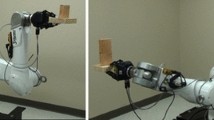Abstract
A procedure is presented for planning optimal trajectories for application to industrial robots. First, trajectories are optimised by considering the nominal dynamics of a robot with rigid links and joints and with constraints on joint torque and speed. The minimum-time optimisation criterion is complemented by a miminal dynamic energy criterion that leads to smoother actuator inputs that do not excite joint vibrations. Weighting factors for these cost functions are then determined by trial simulations. By these means the effect of controller characteristics and elasticity, friction and backlash in the joints may be taken into account. A minimum-time movement for the real-world robot is obtained which displays the dynamical behaviour predicted in the planning procedure. Results from measurements and simulations for a PUMA 562 robot illustrate the approach. Further improvements may be achieved by a custom controller with the feedforward torques as shown in a comparison of trajectories executed with a VAL2 controller and a custom controller.
Similar content being viewed by others
References
F. Pfeiffer and R. Johanni, “A concept for manipulator trajectory planning”,IEEE Journal of Robotics and Automation,RA-3(2), pp. 115–123, April 1987.
K. Shin and N. D. McKay, “Minimum-time control of robotic manipulators with geometric path contraints”,IEEE Transactions on Automatic Control,AC-30(6), pp. 531–541, June 1985.
J. E. Bobrow, S. Dubowsky and J. S. Gibson, “Time-optimal control of robotic manipulators along specified paths”,International Journal of Robotics Research,4(3), 1985.
R. Johanni,Optimale Bahnplanung bei Industrierobotern., vol. 18, no. 51 ofFortschritt-Berichte VDI. VDI Verlag, Düsseldorf, 1988.
J. Hölzl and F. Pfeiffer, “Simulation of robot dynamics including control system”, in A. Sydow (ed.),Computational Systems Analysis 1992, Elsevier Science Publishers, pp. 483–488, 1992.
R. Johanni, “On the automatic generation of the equations of motion for robots with elastically deformable arms”,Preprints of the IFAC-IFIP-IMACS International Symposium on Theory of Robots, Vienna, pp. 195–199, 1986.
J. Steinle, Th. Connolly and F. Pfeiffer, “Three advanced concepts for robot control”,Journal of Laboratory Robotics and Automation, special issue “Advances in Laboratory Robotics Automation”. VCH Publishers, Germany (to appear).
Author information
Authors and Affiliations
Rights and permissions
About this article
Cite this article
Wapenhans, H., Hölzl, J., Steinle, J. et al. Optimal trajectory planning with application to industrial robots. Int J Adv Manuf Technol 9, 49–55 (1994). https://doi.org/10.1007/BF01792867
Issue Date:
DOI: https://doi.org/10.1007/BF01792867




